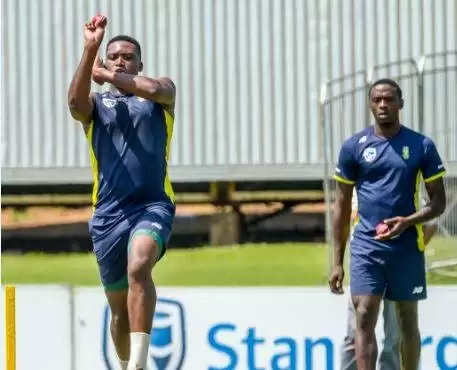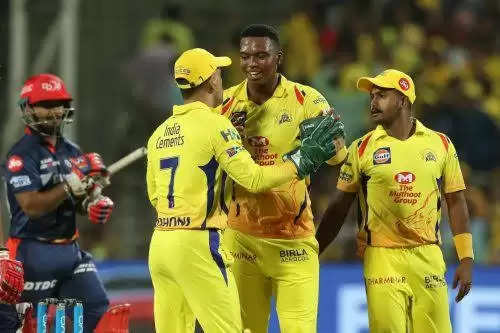Kagiso Rabada, Lungi Ngidi at the forefront of South Africa’s non-fragrant T20 bowling potpourri

In an ideal world, they are the Rolls Royce and Ferrari of modern day fast bowling. One is fluid, lanky, sinewy and runs in with an eerie silence, engine revving at full throttle. The other is noisy, heavy and runs in with a rumble, building tempo all the way through. Kagiso Rabada, evidently the Ferrari, and Lungi Ngidi are very similar, yet distinctly different. You wouldn’t bet one against the other.
Yet, on Friday against Australia, the two were very in a race against each other for the worst bowler of the day. Long before Ashton Agar picked up his hat-trick, the left-hander had his best moment with the bat since a 98 on debut in the Ashes in 2013 when he launched Rabada for 18 runs in the final over of the innings. Earlier in the innings, Aaron Finch and Steven Smith had meted out similar treatment to Ngidi, bludgeoning 11 and 17 runs off the pacer in the 2nd and 5th overs respectively.

Rabada and Ngidi have been touted as the pace bowling spearheads for South Africa across formats since the heydays of Dale Steyn and Morne Morkel. In T20s, they are expected to contain as much as strike. However, as South Africa’s T20 bowling spirals downwards, the two are leading the way. On Friday at Johannesburg, Ngidi went at an economy of 12.3 while Rabada went at 15.

Rabada and Ngidi haven’t quite clicked in sync in T20s yet.
“We don’t quite know what our combinations are [for the T20 World Cup] going to be and we are waiting for guys to step up,” South Africa head coach Mark Boucher said after his side’s excruciating 107-run loss in the first T20I against Australia.
In the bowling attack combinations, on paper at least, Steyn, Ngidi, Rabada, Shamsi and Phehlukwayo pack quite a punch. They bring completely different skillsets to the table and add strength across phases of a T20 bowling innings. But somehow the potpourri hasn’t oozed the warmth and fragrance it was expected to release.
In their last six T20s at home, South Africa have conceded runs at economy rates of 9.8, 11.79, 10.2, 8.8, 8.74 and 8.2. Sure, the bowling combinations have varied but not even their best possible attack on paper has portrayed control on the field with the ball.
“It’s a concern for me. It’s not good enough. In World Cups, you are going to get a lot of games like that,” bowling coach Charl Langeveldt had commented after South Africa failed to defend good totals in two of the three games against England.
Since 2018, the economy rates of South Africa’s bowlers in the shortest format of the game is concerning to say the least. No bowler with more than two matches has conceded at a rate of lesser than seven runs per over. Except Dwaine Pretorius, all pacers who have played at least five matches in this time frame have gone at economy rates of eight or more. Rabada and Ngidi are leading the way here again with the worst (9.75 runs per over) and the second worst economy (9.4) respectively.
Both have failed to contain big hitting batsmen and it could just be South Africa’s biggest concern in the death in a T20 World Cup year. Dale Steyn is phenomenal in this format in the powerplay and Andile Phehlukwayo adds some sting with his cutters and slower balls in the middle overs. Tabraiz Shamsi or Imran Tahir can man the middle overs alongside someone like Dwaine Pretorius. It leaves Ngidi and Rabada, with Phehlukwayo as x-factor, to bowl in the death overs. So far, it hasn’t quite worked out well.
In the recent Mzansi Super League in South Africa, Ngidi and Rabada had contrasting results in the death overs. While Rabada went at an economy rate of 10.83, Ngidi conceded at 8.75, reasonable by T20 death bowling standards. Rabada has gone at eight runs per over or more in 14 of his last 22 T20s spread across internationals, MSL and the IPL. Ideally, though, the two can be excellent in the death as a pair.

Lungi Ngidi had a stunning season with Chennai Super Kings in the IPL in 2018.
Ngidi has a slew of cutters and slower balls up his sleeve while Rabada thrives on his pacy yorkers and quick bumpers. Both have exhibited their respective skills in the biggest T20 league – the IPL – in the last two years.
Ngidi contained KL Rahul, Aaron Finch and Chris Gayle in a league game in 2018 against Kings XI Punjab (how on earth did they not qualify for the play-offs in 2018 with that batting line-up?) to finish with career best figures of 4/10. In the season, Ngidi finished with the second best economy rate (6 runs per over) while taking 11 wickets in seven games.
As recently as last series – against England – Ngidi defended seven runs in the final over, bowling brilliantly in the death to dismiss Ben Stokes (in the 18th over) and Moeen Ali in the final over.
Rabada has shown he can be a beast in the death overs with contrasting skills. He contained an MS Dhoni in his prime in an ODI in 2015 with bumpers and Andre Russell last year in the IPL in a Super Over with inch perfect yorkers.

Rabada has conceded runs at 8rpo or more in 14 of his last 22 T20s.
While the sample size is still small, it is also fairly recent and says one revealing stuff – that the two can be quite a handful as a pair in T20s, particularly in the death, although consistent execution is a concern. 80% of Ngidi’s 2019 MSL wickets came off slower balls or its variations. Rabada, on the other hand, can be deadly with his pacy yorkers and bouncers. It is executing this match after match that has gone awry so far.
Execution, especially in big games or in World Cups, is something South Africa have perennially struggled with. The skills have always been there. Delivering those skills in their best form under pressure is where champions are created and this has been a major hurdle for the Proteas.
“The big thing is to land it [yorkers] under pressure. You can execute it in the nets but it’s when you are in the game, you need to be able to. It’s sometimes difficult to coach that to a guy because he needs to figure it out for himself, once he is out in the middle. You can give him the tools, it’s what he does with them.” – Charl Langeveldt said during the T20Is against England.
In another World Cup year, the form of their two extraordinary talents with the ball will worry the think-tank. Luckily, with a death-overs genius like Langeveldt available as bowling coach – remember the hat-trick that helped defend two runs from four balls against West Indies in 2005? – the Proteas have hope. But they will need him to work overtime to perfectly oil the Royce and the Ferrari engines.

